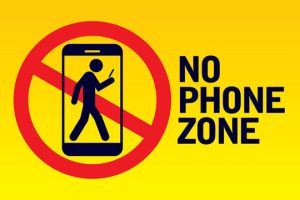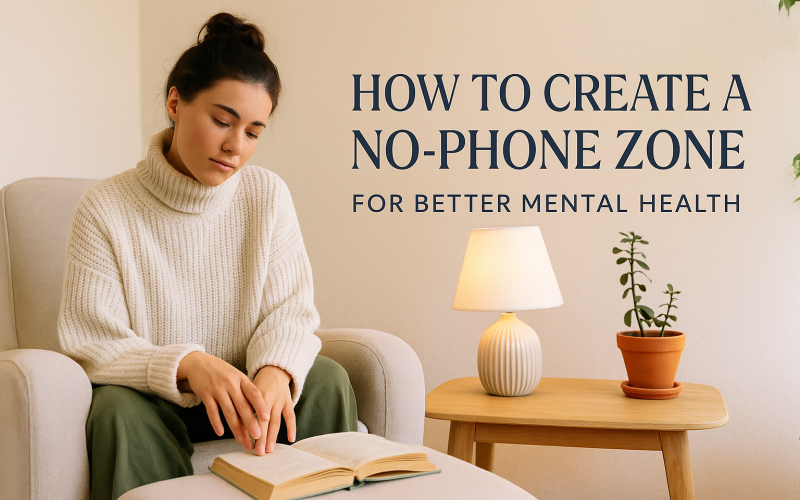Introduction
Phones keep us connected but can also distract us from real life. Constant notifications, endless scrolling, and late‑night texting can harm our mood and focus. Creating a no-phone zone gives your mind a break and helps you Reduce Screen Time. In these phone-free areas, you can read, chat, or simply relax without digital interruptions.
A well‑designed no-phone zone promotes better mental health, lowers stress, and boosts family bonds. In this guide, we’ll explain what a no-phone zone is, why it matters, and how to set one up. You’ll also find screen-free time tips and ways to build lasting phone rules for mindful living.
What Is a No-Phone Zone?
A no-phone zone is a space or time when phones stay out of reach. It can be a room in your home, like the dining area, or hours of the day, such as mealtimes or the hour before bed. In this area, everyone—family, roommates, or even just you—agrees to leave devices behind. The goal is to pause the digital noise and focus on real‑world moments.
This practice supports digital detox by creating clear boundaries between your online and offline life. By carving out phone-free moments, you reclaim time for hobbies, conversations, and self‑care.
Why a No-Phone Zone Helps Your Mental Health

Constant phone use can harm your mood and focus. Checking social media too often can spark comparison and anxiety.
Notifications interrupt tasks and slow you down. Late‑night screen time can disrupt sleep patterns and leave you tired the next day. A no-phone zone fights these effects in several ways:
- Reduced Stress: Without constant pings and alerts, your body can relax.
- Better Sleep: Avoiding screens before bed helps your brain wind down.
- Improved Focus: When your phone is out of the room, you concentrate better on work or reading.
- Deeper Connections: Shared phone-free time at the dinner table or during family games builds stronger bonds.
By giving your mind a break, you practice mindful living. Over time, you feel calmer and more in control of your attention.
How to Set Up Your No-Phone Zone

Creating a phone-free area takes planning and clear rules. Follow these steps:
Choose Your Zone:
Pick a place that fits your needs. It could be the dining table, a reading nook, or the bedroom. Make sure it’s a spot where you spend enough time to benefit from being phone-free.
Clear Visible Reminders:
Place a small basket or shelf where phones go when you enter the zone. Label it “No Phones” or use a decorative box. The visual cue makes it easy to remember the rule.
Set Boundaries:
Decide which activities are phone-free. Common choices include meals, reading time, and family game night. Agree on start and end times, such as 6–8 pm for dinner or 30 minutes after waking up.
Communicate with Others:
If you live with family or roommates, explain why the no-phone zone matters. Invite them to join you. When everyone follows the rules, the zone feels more natural and respectful.
Prepare Alternatives:
Stock up on books, puzzles, board games, or a journal. Having other options at hand reduces the urge to reach for your phone.
By following these steps, you transform a regular spot into a digital-free oasis for better mental well‑being.
Tips for Maintaining a Phone-Free Area
Keeping a no-phone zone working over time can be challenging. Try these screen-free time tips to stay on track:
- Enforce Gently: If someone forgets, give a friendly reminder rather than scolding.
- Make It Fun: Host weekly phone-free dinners with themes, like taco night or fondue.
- Track Progress: Use a calendar or a sticker chart to mark successful days.
- Reward Success: Treat yourself or your family to a small reward after a week of phone-free meals.
- Adjust as Needed: If dinner feels too late, shift the zone to morning coffee or a pre‑bed wind‑down.
These simple strategies help the no-phone habit stick and keep your zone a positive, stress‑free space.
Dealing with Common Challenges

Even with good intentions, no-phone zones can face hiccups. Here’s how to overcome them:
Temptation to Check:
Place your phone far enough away that you have to get up to grab it. This extra step often breaks the impulse.
Urgent Calls or Messages:
Agree on an exception policy.
Resistance from Kids or Partners:
Lead by example. When they see you enjoying phone-free time, they are more likely to join in.
Work Demands:
If you must stay reachable, consider using “Do Not Disturb” mode with specific contacts allowed through. Then keep your phone face down to avoid non‑urgent pings.
By anticipating these issues and planning solutions, you strengthen your commitment and protect your mental space.
Table: No-Phone Zone Setup Guide
| Step | Action | Benefit |
|---|---|---|
| Choose Your Zone | Select a room or time block | Creates clear boundary |
| Clear Visible Reminders | Place a labeled basket or box | Quick visual cue |
| Set Boundaries | Define phone-free activities and hours | Ensures consistency |
| Communicate with Others | Explain rules and invite participation | Builds shared commitment |
| Prepare Alternatives | Provide books, games, or journals | Reduces temptation |
Integrating No-Phone Zones into Daily Life

A true digital detox goes beyond one spot. You can build mini no-phone moments throughout the day:
- Morning Ritual: Keep your phone in another room for the first 30 minutes after waking. Use that time for stretching or journaling.
- Work Breaks: Step away from your desk and leave your phone behind when you take a walk or have a snack.
- Evening Wind-Down: Charge your phone outside the bedroom. Read or meditate before bed instead of scrolling.
By scattering phone-free pockets throughout your day, you reinforce the habit and enjoy more moments of calm.
Conclusion
By choosing a clear area, setting gentle rules, and offering fun alternatives, you turn Phone-Free Time into a rewarding ritual.
As you integrate no-phone moments into your daily life, you practice true mindful living and reclaim control of your attention. Start small—perhaps with one meal a day—and watch how your well‑being flourishes.












